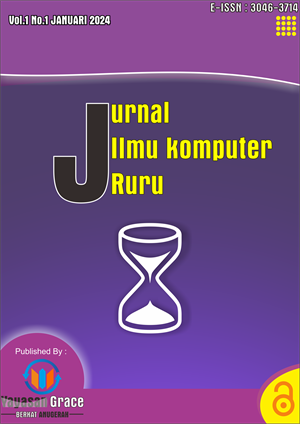EVALUASI KINERJA METODE ANALYTICAL HIERARCHY PROCESS (AHP) DALAM PENELUSURAN ASET PADA LINGKUNGAN BISNIS: STUDI KASUS PADA INDUSTRI PERBANKAN
Keywords:
Analytical Hierarchy Process (AHP), Asset Tracing, Banking Industry, Decision Making, Asset ManagementAbstract
Asset tracing is an important activity in business management, especially in the banking industry where asset management has direct implications for a company's financial health and sustainability. In this context, this study aims to evaluate the performance of the Analytical Hierarchy Process (AHP) method in asset tracing, with case studies in the banking industry. This study adopts a quantitative approach by applying AHP in selecting asset tracing priorities in the banking business environment. Asset-related data, such as value, risk, and strategic importance, are collected and analyzed to support the decision-making process. Furthermore, AHP is applied to determine the relative weighting of the relevant criteria and generate a rating for each asset based on the assessment of those criteria. The results of the performance evaluation of the AHP method in asset tracing in the banking industry show that this approach provides a systematic and structured framework for decision making. By using AHP, asset ratings can be determined more objectively and transparently, reducing the risk of errors and misappropriations in resource allocation. In addition, AHP allows management to prioritize asset tracing based on the company's business objectives and strategic needs. In conclusion, the performance evaluation of the AHP method in asset tracing in the business environment, especially in the banking industry, shows the potential to improve the efficiency and effectiveness of asset management. With a structured, data-driven approach like AHP, companies can optimize resource usage and reduce the risk of loss caused by assets that are not strategically optimized.
References
G. S. Pambudi and A. Arvianto, “Rancang Bangun Sistem Informasi Manajemen Aset Berbasis Web Untuk Optimalisasi Penelusuran Aset di Teknik Industri UNDIP,” vol. XI, no. 3, pp. 187–196, 2016.
S. Mairuhu and J. J. Tinangon, “Analisis Penerapan Metode Penyusutan Aktiva Tetap dan Implikasinya Terhadap Laba Perusahaan Pada Perum Bulog Divre Sulut dan Gorontalo,” J. EMBA J. Ris. Ekon. Manajemen, Bisnis Dan Akunt., vol. 2, no. 4, pp. 404–412, 2014.
H. Muchtar, Manajemen Aset (Privat dan Publik). Yogyakarta: LaksBan, 2011.
D. D. Siregar, Management Asset Srategi Penataan Konsep Pembangunan Berkelanjutan secara Nasional dalam Konteks Kepala Daerah sebagai CEO’s pada Era Globalisasi dan Otonomi Daerah. Jakarta: PT. Gramedia Pustaka Utama, 2004.
L. D. Council, “Aset Management Plan,” 2005. www:Lewes.gov.uk.
J. Rainer and C. . Cegielski, Introduction to Information System. Singapore: John Wiley & Sons, 2013.
F. Belanger and C. V. Slyke, Information System for Business. New York: John Wiley & Sons, 2012.
I. M. Sari and L. Frisila, “Information System Management on Asset Management in PT. PLN West Java Transmission Regional,” 2019, doi: 10.1109/ICHVEPS47643.2019.9011033.
R. L. Winata and S. Rahayu, “Sistem Informasi Manajemen Aset IT di PT. Nissin Foods Indonesia,” J. Cendikia, vol. 18, p. P-ISSN:0216-9436, E-ISSN:2622-6782, 2019.
Y. B. Yun, H. Nakayama, and M. Arakawa, “Multiple Criteria Decision Making with Generalized DEA and an Aspiration Level Method,” Eur. J. Oper. Res., vol. 158, no. 3, pp. 697–706, 2004.
D. E. Kurniawan, T. B. Prayogo, and S. Wahyuni, “Studi Penerapan Manajemen Aset Irigasi pada Daerah Irigasi Nglirip Kabupaten Tuban,” J. Teknol. dan Rekayasa Sumber Daya Air, vol. 1, no. 2, pp. 764–771, 2021, doi: 10.21776/ub.jtresda.2021.001.02.35.
R. Santriono and Rusdianto Roestam, “Analisis dan Perancangan Sistem Pendukung Keputusan Pemilihan Paket Internet Operator Telekomunikasi dengan Metode AHP (Analytical Hierarchy Process),” vol. 4, no. 1, pp. 75–84, 2019.
W. Atthirawong and B. Maccarthy, “An Application of the Analytical Hierarchy Process to International Location Decision-Making,” Proc. 7th Annu. Cambridge Int. Manuf. Symp. Restruct. Glob. Manuf., no. May, pp. 1–18, 2002.
P. Davidsson, S. Johansson, and M. Svahnberg, “Using the analytic hierarchy process for evaluating multi-agent system architecture candidates,” Lect. Notes Comput. Sci. (including Subser. Lect. Notes Artif. Intell. Lect. Notes Bioinformatics), vol. 3950 LNCS, no. July, pp. 205–217, 2006, doi: 10.1007/11752660_16.
F. R. Sari and D. I. Sensuse, “Penerapan Metode Analytical Hierarchy Process dalam Sistem Penunjang Keputusan untuk Pemilihan Asurasi,” J. Sist. Inf. MTI-UI, vol. 4, no. 2, pp. 100–109, 2016.
L. W. Santoso, A. Setiawan, and A. Handojo, “Pembuatan Aplikasi Sistem Seleksi Calon Pegawai Dan Pemilihan Supplier Dengan Metode Analytic Network Process (Anp) Dan Analytic Hierarchy Process (Ahp) Di Pt X.,” in Seminar Nasional Teknologi Industri, 2010, pp. 1–8.
I. Sommerville, Software Engineering, Ninth Edit. United States of America: Pearson Education, 2011.
Y. Liu, C. M. Eckert, and C. Earl, A review of fuzzy AHP methods for decision-making with subjective judgements. Elsevier Ltd, 2020.
S. Kaganski, J. Majak, and K. Karjust, “Fuzzy AHP as a tool prioritization of key performance indicators,” Procedia CIRP, vol. 72, pp. 1227–1232, 2018, doi: 10.1016/j.procir.2018.03.097.
S. Rizky, Konsep Dasar Rekayasa Perangkat Lunak. Jakarta: Prestasi Jakarta, 2011.
Downloads
Published
Issue
Section
License
Copyright (c) 2024 Jurnal Ilmu Komputer Ruru

This work is licensed under a Creative Commons Attribution-ShareAlike 4.0 International License.




